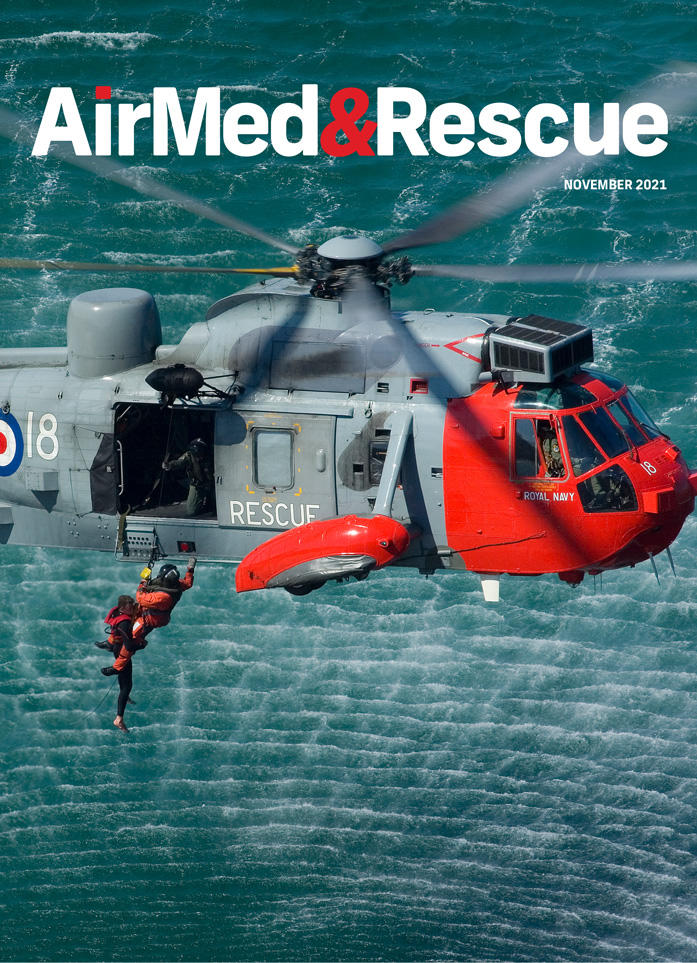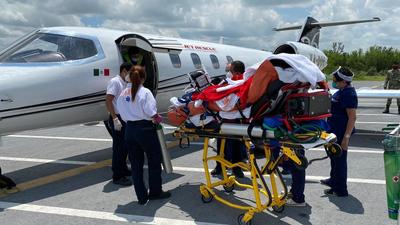Intensive care in the air

Captain Ed Davidson, Chief Safety Officer at MedHealth Partners, profiles the first ECMO-dependent patient transport conducted by both the transferring hospitals and MedHealth Partners
Historically, extra-corporeal membrane oxygenation – ECMO in the parlance of those medical professionals practicing it – has typically only been available to patients in highly specialized medical centers and only in their intensive care units.
Until recently, ECMO was considered only available in a fixed setting in an ICU, which restricted the transport of seriously ill patients requiring this ongoing life support measure to short distances via ground ambulance or helicopter within the same metropolitan area.
Not anymore. Angel MedFlight, a Georgia-based MedHealth Partners subsidiary, recently moved a Covid-19 patient who required a double lung transplant and was attached to ECMO equipment directly to the transplant hospital twice – not just locally but several hundred miles via air ambulance. First, from West Palm Beach to Atlanta Piedmont Hospital and, after he was stabilized by physicians and ECMO specialists, to Baltimore’s University of Maryland Medical Center for a double lung procedure under the direction of their transplant program. Both flights occurred using externally mounted ECMO equipment attached to the medical ‘sled’ in the aircraft and specially trained air ambulance clinicians.
This accomplishment is a testament to the creativity and dedication of both the treating physicians as well as the air ambulance provider and has opened a new road to recovery for those patients needing lung transplants and ECMO treatment who are living long distances from a transplant center.
The treatment
ECMO takes over the work of the lungs, and at times the heart, when conventional ventilator management, medications and prone positioning have proven unsuccessful in providing adequate oxygenation or removal of CO2 from the body, buying time for the care provider to address their underlying condition. In many cases, it is the only viable bridge until the underlying condition improves or a transplant can be arranged and is considered the only true life-saving procedure for these patients.
The process also frequently requires a perfusionist for patient transport as well as a physician who is trained in ECMO. Cannulation is also often required during the transport. Taking these resources out of a hospital that is already resource-constrained makes long-distance patient transport particularly challenging. To add to the risks, most hospital teams are not trained in the patient impacts inherent with aviation medicine. This makes partnering with the expertise of trained air ambulance clinicians so important.
Until recently, ECMO was considered only available in a fixed setting in an ICU
The patient
The 24-year-old patient, ventilated and in a medically induced coma suffering from life-threatening Covid-19 lung damage, was being treated in his hometown hospital, St. Mary’s Medical Center in Florida, US. However, when standard treatment protocols were not being effective, the treating physician realized ECMO was required to keep him alive while the lungs healed – a procedure only 10 per cent of US hospitals have the equipment and training to perform, and which the local hospital did not.
After checking numerous closer medical providers in Florida to no avail, St. Mary’s contacted the Atlanta Piedmont Hospital team, as their experience and capabilities in ECMO are well regarded. The challenge was how to get him there safely: clearly, the distance was significantly outside helicopter range and a day-long ambulance ride on the typically traffic clogged Interstate-75 was also not considered medically feasible. After reviewing the patient’s charts, the treating physician, Dr Peter Barrett, Director of Piedmont’s cardiac intensive care unit, recognized that the patient’s lungs were struggling to function, yet the rest of his system appeared to be in fairly good shape. The care co-ordinators at Piedmont and St. Mary’s approached MedHealth Partners to discuss the potential for its subsidiary, Scottsdale-based Angel MedFlight Worldwide Air Ambulance, to provide transport and, more importantly, to determine whether ECMO could be safely performed enroute.
Since neither hospital nor Angel MedFlight had ever attempted an ECMO air transport, Medway’s flight operations, clinical and business operations teams, directed by Matt Kinney, Vice President of Flight Operations, and Bambi Pish-Derr, Senior Vice President of Clinical Operations, worked together with the Piedmont ECMO team leadership to develop a process to safely transport the patient via both ground and air. The result was a creative and exceptionally compact process that worked flawlessly hospital to hospital.
The transfer
With the patient now stabilized on ECMO at Piedmont, Barrett soon recognized the patient’s lungs were too damaged to recover, therefore necessitating a double lung transplant. While Piedmont performs several other organ transplants routinely, they do not have expertise in that specialty. Barrett contacted the well-known lung transplant team at several well-regarded transplant centers, eventually settling on the University of Maryland Medical Center’s Lung Transplant Program led by Dr Robert Reed.
Since the transplant could not occur in Atlanta, now came yet another need to move the patient via ground and air ambulance to Baltimore. Once again, the teams at Piedmont and Angel MedFlight collaborated to re-establish the inflight ECMO process and safely relocated the patient over 500 nautical miles and over three hours of total transit time.
On 28 June, the patient underwent an eight-hour double lung transplant at Maryland Medical Center and is now recovering well while undergoing physical therapy. Not only is his prognosis good, but now, with the addition of this new capability at Angel MedFlight, physicians and patient care managers can reliably and safely move an ECMO-dependent patient to the organ transplant center and offer life-saving treatment to patients who, in the past, may not have survived.

October 2021
Issue
- The demand for automation reveals its shortcomings meeting the human factor
- How virtual and augmented reality meets the needs of SAR/HEMS training
- Keeping critical communications infrastructure live during Hurricane Ida
- How logistics is the critical challenge of neonatal air transport
- The latest SAR equipment that pairs innovation with affordability
- Interview with Rob Pennel about the EASA South East Asia Partnership Program
- And more
Captain Ed Davidson
Captain Davidson has over 35 years of air transport flight operations, safety, and line flying experience. Davidson currently provides aerospace advisory services to air transport corporate executives and business owners through his management consulting firm, Aerospace Partners, and is Chief Safety Officer at MedHealth Partners.

